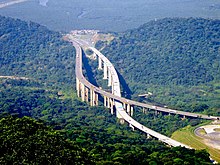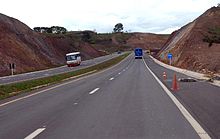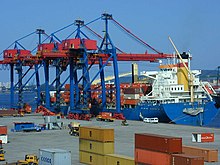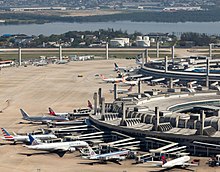Transport in Brazil


Transport infrastructure in Brazil is characterized by strong regional differences and lack of development of the national rail network.[1] Brazil's fast-growing economy, and especially the growth in exports, will place increasing demands on the transport networks.[2] However, sizeable new investments that are expected to address some of the issues are either planned or in progress.[2][3] It is common to travel domestically by air because the price is low.[4] Brazil has the second highest number of airports in the world, after the USA.[5]
Railways
[edit]

The Brazilian railway network has an extension of about 30,000 km (18,641 mi). It is basically used for transporting ores.[5] Usually, the railway sector was treated in a secondary way in Brazil, due to logistical, economic or political difficulties to install more railways.
The Brazilian railroad system had a great expansion between 1875 and 1920. The heyday of the railway modal was interrupted during the Getúlio Vargas government, which prioritized the road modal. In the 1940s, the railway network was already facing several problems, from low-powered locomotives to uneconomical layouts. In 1957, a state-owned company was created, the National Railroad Network (RFFSA), which started to manage 18 railroads in the Union. Several deficit railways were closed under the promise of state investment in new projects, which did not happen. The actions were centralized in the government until the opening of the market in 1990. So, the National Privatization Plan was instituted, with dozens of concessions being made. However, they ended up concentrating the railways, mainly, in three large business groups, América Latina Logística (ALL), Vale S.A. and MRS Logística. The refurbishment generated an increase in productivity (cargoes transported increased by 30% with the same railway line). However, the main problem was that the reform not only gave away the railway line, but also geographical exclusivity. This resulted in the non-creation of competitive incentives for the expansion and renewal of the existing network. With the State maintaining the opening of new railways a difficult, slow and bureaucratic process, as it maintains the total monopoly of power over this sector, the railways did not expand any further in the country, and the sector was very outdated.[6][7]
In 2021, a New Framework for Railways was created, allowing the construction of railways by authorization, as occurs in the exploration of infrastructure in sectors such as telecommunications, electricity and ports. It's also possible to authorize the exploration of stretches not implemented, idle, or in the process of being returned or deactivated. With the change of rules in the sector, in December 2021, there were already requests to open 15,000 km (9,321 mi) of new tracks, in 64 requests for implementation of new railways. Nine new railroads had already been authorized by the Federal Government, in 3,506 km (2,179 mi) of new tracks.[8][9][10]
- Total actual network: 29,888 km of railroad and 1,411 km of subway and light rail[11][5]
- Broad gauge: 4,932 km 1,600 mm (5 ft 3 in) gauge (939 km electrified)
- Narrow gauge: 23,341 km 1,000 mm (3 ft 3+3⁄8 in) gauge (24 km electrified)
- Dual gauge: 396 km 1000 mm and 1600 mm gauges (three rails)
- Standard gauge: 194 km 1,435 mm (4 ft 8+1⁄2 in) gauge (2014)
- Estrada de Ferro do Amapá in the middle of the Amazon Rainforest also used standard gauge.
- A 12 km section of the former 2 ft 6 in (762 mm) gauge Estrada de Ferro Oeste de Minas is retained as a heritage railway.
Metros and light rail transit (combined)
[edit]
|
Note (*): Light Rail Transit, Light Metro, Tram or Subway-Surface fully or partially operated.
Railway links with adjacent countries
[edit]International rail links exist between Brazil and Argentina, Bolivia and Uruguay.
Tramways
[edit]Brazil had a hundred tramway systems.[27] Currently, there are vintage tramways operating in Belém, Campinas, Campos do Jordão, Itatinga, Rio de Janeiro and Santos.[28][29][30][31][32][33]
Highways
[edit]






Brazil has more than 1,720,700 km (1,069,193 mi) of roads, of which 213,452 km (132,633 mi) are paved (12,4%), and about 17,000 km (10,563 mi) are divided highways, 6,300 km (3,915 mi) only in the State of São Paulo. Currently it is possible to travel from Rio Grande, in the extreme south of the country, to Brasília (2,580 km (1,603 mi)) or Casimiro de Abreu, in the state of Rio de Janeiro (2,045 km (1,271 mi)), only on divided highways. The total of paved roads increased from 35,496 km (22,056 mi) in 1967 to 215,000 km (133,595 mi) in 2018.[34] The two most important highways in the country are BR-101 and BR-116.[35]
Although Brazil has the largest duplicated road network in Latin America, it's considered insufficient for the country's needs: in 2021, it was calculated that the ideal amount of duplicated roads would be something around from 35,000 km (21,748 mi) to 42,000 km (26,098 mi). The main road axes also have problems because they often have inadequate geometry and constructive characteristics that don't allow quality long-distance flow (non-interference from local traffic and high speed). The Brazilian Federal Government has never implemented a National Highway Plan at the same level as developed countries such as the US, Japan or European countries, which specifically aimed at inter-regional travel, and which should preferably be served by highways (which would differ from the common duplicated highways by geometric pattern, access control without access to neighboring lots, zero level crossings and returns, prohibition of circulation of non-motorized vehicles such as cyclists, animal traction or human propulsion, as per the Vienna Convention). The Brazilian State, despite some planning efforts, has been guided by a reactive action to the increase in demand (only duplicating some roads with old and inadequate layout) and not by a purposeful vision, directing occupation and economic density in the territory. Another problem is the lack of directing the Union Budget towards infrastructure works: in Brazil there is no law that guarantees funds from the Federal Budget for works on highways and other modes of transport (unlike what happens in sectors such as Education and Health), depending exclusively on the goodwill of the rulers. In the US, for example, the gasoline tax can only be used for transport infrastructure works. Brazil even invested 1.5% of the country's budget in infrastructure in the 1970s, being the time when the most investment was made in highways; but in the 1990s, only 0.1% of the budget was invested in this sector, maintaining an average of 0.5% in the 2000s and 2010, insufficient amounts for the construction of an adequate road network. For comparative purposes, the average investment of the US and the European Union was 1% between 1995 and 2013, even though they already have a much more advanced road infrastructure than Brazil.[36][37]
The country has a medium rate of car ownership of 471 per 1000 people,[38] however in comparison to the other developing economies of the BRIC group Brazil exceeds India and China.
The country still has several states where paved access to 100% of the state's municipalities has not yet been reached. Some states have 100% of cities with asphalt access, such as Santa Catarina, which reached this goal in 2014;[39] Paraíba, which reached this goal in 2017,[40] and Alagoas, which reached this goal in 2021 [41] In states like Rio Grande do Sul, in 2020, there were still 54 cities without asphalt access.[42] In Paraná, in 2021, there were still 4 cities without asphalt access.[43] In Minas Gerais, in 2016, there were still 5 cities without asphalt access.[44]
Waterways
[edit]
50,000 km navigable (most in areas remote from industry or population) (2012)[5]
Among the main Brazilian waterways, two stand out: Hidrovia Tietê-Paraná (which has a length of 2,400 km, 1,600 on the Paraná River and 800 km on the Tietê River, draining agricultural production from the states of Mato Grosso, Mato Grosso do Sul, Goiás and part of Rondônia, Tocantins and Minas Gerais) and Hidrovia do Solimões-Amazonas (it has two sections: Solimões, which extends from Tabatinga to Manaus, with approximately 1600 km, and Amazonas, which extends from Manaus to Belém, with 1650 km. Almost entirely passenger transport from the Amazon plain is done by this waterway, in addition to practically all cargo transportation that is directed to the major regional centers of Belém and Manaus). In Brazil, this transport is still underutilized: the most important waterway stretches, from an economic point of view, are found in the Southeast and South of the country. Its full use still depends on the construction of locks, major dredging works and, mainly, of ports that allow intermodal integration.[45][46][47]
Pipelines
[edit]- condensate/gas 62 km
- natural gas 11,696 km (1,165 km distribution, 4,794 km transport)
- liquid petroleum gas 353 km (37 km distribution, 40 km transport)
- crude oil 4,517 km (1,985 km distribution)
- refined products 5,959 km (1,165 km distribution, 4,794 km transport)[5]
Seaports and harbors
[edit]


The busiest port in the country, and the 2nd busiest in all of Latin America, losing only to the Port of Colón, is the Port of Santos. Other high-movement ports are the Port of Rio de Janeiro, Port of Paranaguá, Port of Itajaí, Port of Rio Grande, Port of São Francisco do Sul and Suape Port.[48]
Atlantic Ocean
[edit]Amazon river
[edit]Paraguay River (international water way)
[edit]Merchant marine
[edit]770 ships (1,000 gross tonnage (GT) (or over) totaling 3,964,808 GT/9,909,094 tonnes deadweight (DWT)
ships by type: (1999, 2019 and 2021 est.)[49][5]
|
Airports
[edit]

The country has the second largest number of airports in the world, behind only the United States. São Paulo/Guarulhos, is the largest and busiest in the country. Brazil has 37 international airports,[50] such as those in Rio de Janeiro, Brasília, Belo Horizonte, Porto Alegre, Florianópolis, Cuiabá, Salvador, Recife, Fortaleza, Belém and Manaus, among others.
Most international flights must go to São Paulo–Guarulhos International Airport or Rio de Janeiro–Galeão International Airport. Belo Horizonte is the main international airport outside Rio de Janeiro and São Paulo. A few go to Brasília, Recife, Natal, and just recently Fortaleza has accepted international flights.
As of 2020, Brazil had the eighth largest passenger air market in the world.[51]
Airports - with paved runways
[edit]- total: 698[5]
- over 3,047 m: 7
- 2,438 to 3,047 m: 27
- 1,524 to 2,437 m: 179
- 914 to 1,523 m: 436 (2017)
- under 914 m: 39 (2017)
Airports - with unpaved runways
[edit]- total: 3,395[5]
- 1,524 to 2,437 m: 92
- 914 to 1,523 m: 1,619
- under 914 m: 1,684 (2013)
Main airlines
[edit]
Heliports
[edit]- 16 (2007)
- 13 (2010)
- 13 (2013)[5]
See also
[edit]- National Association of Cargo Transportation and Logistics (Brazil)
- Rail transport by country
- List of countries by road network size
References
[edit]- ^ "Logistics in Brazil - DHL Logistik". Archived from the original on 2012-07-24.
- ^ a b "Welcome to Invest in Canada | Bienvenue au site Investir au Canada" (PDF). Archived from the original (PDF) on 2012-09-22. Retrieved 2012-09-22.
- ^ Home page | The world's leading construction web site[permanent dead link]
- ^ "Travelling in Brazil - Transportation: Air, bus, car..." www.aboutbrasil.com. Archived from the original on 2020-11-27. Retrieved 2020-10-13.
- ^ a b c d e f g h i "Brazil". The World Factbook (2024 ed.). Central Intelligence Agency. Retrieved 26 December 2021. (Archived 2021 edition.)
- ^ "Por que o Brasil quase não tem ferrovias e como mudar isso". Archived from the original on 2021-12-30. Retrieved 2021-12-30.
- ^ "Por que o Brasil não investe em ferrovias? E por que deveria investir". 8 May 2018.
- ^ "Sancionado novo marco legal do transporte ferroviário".
- ^ "Governo Federal abre Setembro Ferroviário com 10 pedidos para novas ferrovias e previsão de R$ 53 bilhões em novos investimentos".
- ^ "Em dia de sanção do novo Marco Legal das Ferrovias, Pro Trilhos alcança 64 requerimentos e ultrapassa R$ 180 bilhões em investimentos projetados".
- ^ "Extensão das linhas principais e ramais por concessionária". Confederação Nacional do Transporte. 21 December 2020. Retrieved 26 December 2021.
- ^ "VLT do Cariri". Metrô de Fortaleza (in Brazilian Portuguese). Retrieved 26 December 2021.
- ^ "VLT de Sobral". Metrô de Fortaleza (in Brazilian Portuguese). Retrieved 26 December 2021.
- ^ "Malha Viária: Belo Horizonte". Companhia Brasileira de Trens Urbanos - CBTU (in Portuguese). 20 July 2020. Archived from the original on 7 February 2019. Retrieved 26 December 2021.
- ^ "Malha Viária: João Pessoa". Companhia Brasileira de Trens Urbanos - CBTU (in Portuguese). 1 June 2021. Archived from the original on 26 December 2021. Retrieved 26 December 2021.
- ^ "Malha Viária: Maceió". Companhia Brasileira de Trens Urbanos - CBTU (in Portuguese). 20 July 2020. Retrieved 26 December 2021.
- ^ "Quem Somos". CCR Metrô Bahia (in Portuguese). Retrieved 26 December 2021.
- ^ "Estrutura | Raio-x". Companhia do Metropolitano do Distrito Federal (in Portuguese). 20 October 2021. Retrieved 26 December 2021.
- ^ "Estações e Sistema". Empresa de Trens Urbanos de Porto Alegre - Trensurb (in Portuguese). Retrieved 26 December 2021.
- ^ "Sistema metroviário". Metrô de Fortaleza (in Brazilian Portuguese). Retrieved 26 December 2021.
- ^ "Malha Viária: Natal". Companhia Brasileira de Trens Urbanos - CBTU (in Portuguese). March 2019. Archived from the original on 21 January 2022. Retrieved 26 December 2021.
- ^ "Malha Viária: Recife". Companhia Brasileira de Trens Urbanos - CBTU (in Portuguese). Archived from the original on 14 December 2021. Retrieved 26 December 2021.
- ^ "Corporate Profile". MetroRio (in Portuguese). Archived from the original on 26 December 2021. Retrieved 26 December 2021.
- ^ "Veículo Leve Sobre Trilhos - VLT". Prefeitura da Cidade do Rio de Janeiro (in Portuguese). Retrieved 26 December 2021.
- ^ "QUEM SOMOS". MetroSP (in Portuguese). Archived from the original on 27 April 2018. Retrieved 26 December 2021.
- ^ "Empreendimentos - VLT da Baixada Santista - Veículo Leve sobre Trilhos". Empresa Metropolitana de Transportes Urbanos de São Paulo - EMTU/SP (in Portuguese). Retrieved 26 December 2021.
- ^ "INTRODUCTION". www.tramz.com. Archived from the original on 2008-07-23. Retrieved 2007-01-16.
- ^ "The Tramways of Belém". www.tramz.com. Archived from the original on 2009-05-02. Retrieved 2007-08-01.
- ^ "The Tramways of Campinas". www.tramz.com. Archived from the original on 2009-09-18. Retrieved 2007-08-01.
- ^ "Campos do Jordão". www.tramz.com. Archived from the original on 2009-03-04. Retrieved 2007-08-01.
- ^ "CODESP hydroelectric complex (Brazil)". www.tramz.com. Archived from the original on 2010-05-31. Retrieved 2007-08-01.
- ^ "THE SANTA TERESA TRAMWAY". www.tramz.com. Archived from the original on 2009-05-04. Retrieved 2007-08-01.
- ^ "THE SCOTTISH TRAMS OF SANTOS". www.tramz.com. Archived from the original on 2010-05-31. Retrieved 2007-08-01.
- ^ "Anuário CNT do Transporte 2021" (PDF). CNT. p. 11. Archived (PDF) from the original on 2022-10-09. Retrieved 26 December 2021.
- ^ "Anuário CNT do transporte 2018".
- ^ Silvio Barbosa da Silva Júnior. "Proposta para uma rede brasileira de autoestradas". Retrieved 29 December 2021.
- ^ Fernando Martins, Ricardo Lourenço e Ignacia Oliver. "INFRAESTRUTURA RODOVIÁRIA NO BRASIL: PARA ONDE VAMOS?" (PDF). Archived (PDF) from the original on 2022-10-09. Retrieved 29 December 2021.
- ^ "Taxa de motorização no Brasil: veja o aumento em 20 anos" (in Portuguese). Retrieved 26 December 2021.
- ^ Governo de Santa Catarina. "Santa Catarina tem, agora, acesso asfaltado a todas as 295 cidades". Archived from the original on 30 December 2021. Retrieved 30 December 2021.
- ^ Governo da Paraíba. "Ricardo entrega estrada de Carrapateira e decreta fim do isolamento asfáltico na Paraíba". Archived from the original on 30 December 2021. Retrieved 30 December 2021.
- ^ Correio dos Municipios. "Com entrega de rodovia em Pindoba, Alagoas bate meta de asfaltar 100% dos acessos aos municípios". Archived from the original on 30 December 2021. Retrieved 30 December 2021.
- ^ RBS. "No RS, 54 municípios ainda não têm acesso asfáltico e sofrem com poeira, buracos e dificuldades econômicas". Retrieved 30 December 2021.
- ^ G1 Globo. "Quatro cidades do Paraná não têm acessos por rodovias estaduais asfaltadas; moradores enfrentam lama e transtornos". Retrieved 30 December 2021.
{{cite web}}: CS1 maint: numeric names: authors list (link) - ^ Estadão. "Moradores de cidades sem ligação asfáltica vivem isolados por lama e poeira". Retrieved 30 December 2021.
- ^ "Hidrovias como alternativa para o transporte de etanol".
- ^ "Hidrovia Tietê Paraná". Archived from the original on 2021-12-14. Retrieved 2021-12-30.
- ^ "Hidrovia do Solimões".
- ^ "Port Activity of Latin America and the Caribbean 2018" (PDF).
- ^ "Frota registrada na navegação de cabotagem e de longo curso por tipo de embarcação". Confederação Nacional do Transporte. Retrieved 26 December 2021.
- ^ "Lista de aeroportos Internacionais - 2018" (xlsx). Confederação Nacional do Transporte - Anuário 2021 (in Portuguese). 12 July 2018. Retrieved 26 December 2021.
- ^ World Bank Datebase, http://data.worldbank.org/indicator/IS.AIR.PSGR

